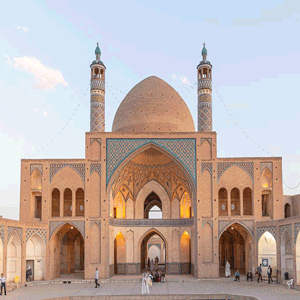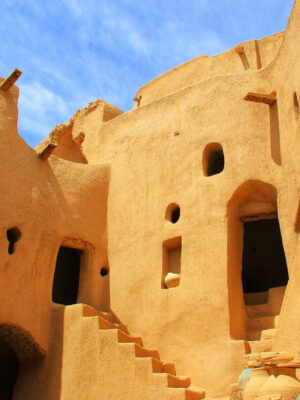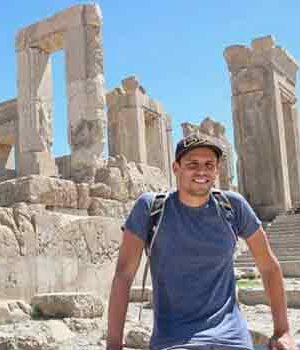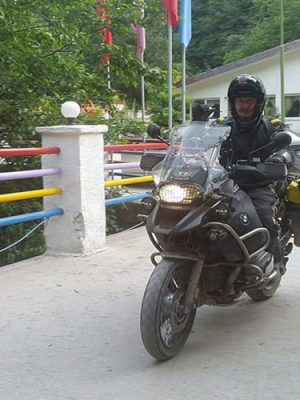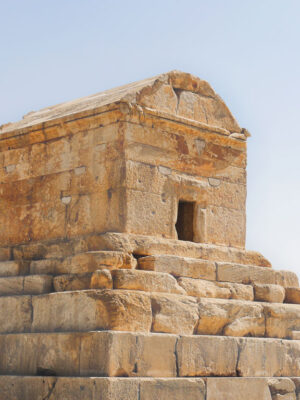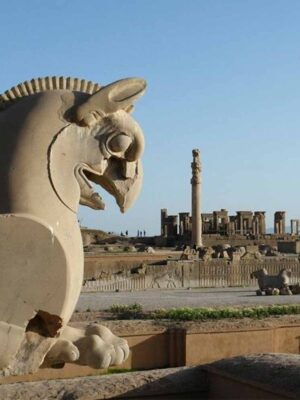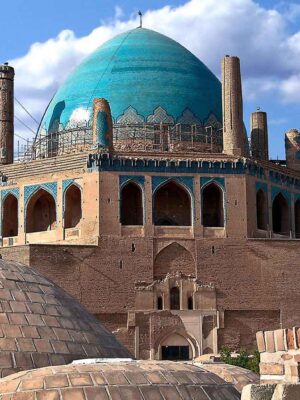Takht-e Soleyman
The enigmatic archaeological ensemble called Takht-e Soleyman (‘Throne of Solomon’) is located 45 kilometers northeast of Takab in West Azarbaijan province and includes significant remains from Sassanian and IlKhanid periods. The strong symbolic and spiritual significance of this site acknowledges the continuation of a culture that revered fire and water over a period of some 2,500 years. Takht-e Soleyman is situated on a valley 2,500 meters above sea level, surrounded by mountains, a location most likely chosen for its natural distinctions. At the center of the site is a fortified oval platform 60 meters above the surrounding plains that measures about 350 meters by 550 meters. On this platform is an artesian lake (about 120 meters deep), a Zoroastrian fire temple, a temple dedicated to Anahita (goddess of waters), and a Sassanian royal sanctuary.

The Sassanians inhabited the site starting in the 5th century, where they built the royal sanctuary on the platform. The sanctuary was circumscribed by a stone wall 13 meters high, with 38 towers and two entrances (north and south) .The main buildings are on the north side of the lake, forming a nearly square compound with the Zoroastrian fire temple in the center. This temple, built in fired bricks, is square in plan. To the east of the fire temple there is another square hall reserved for the ‘everlasting fire’. Further to the east there is the Anahita temple, also square in plan. The royal residences are situated to the west of the temples. The lake is an integral part of the configuration and was surrounded by a rectangular fence.
This site was destroyed at the end of the Sassanian era but was revived and partly rebuilt by the Ilkhanids in the 13th century. A few kilometers west is an ancient volcano, Zendan-e Soleyman (Solomon’s prison), which rises about 100 meters above its surroundings, with remains of shrines dating from the first millennium B.C. It contains an 80-meter deep hole, about 65 meters in diameter, which was once filled with water. The 10-hectare property also includes Tepe Majid, an archaeological mound culturally related to Zendan-e Soleyman; The Belqeis Mountain (3,200 meters high), situated 7.5 km northeast of Takht-e Soleyman, include remains of a Sassanian citadel, built-in yellow sandstone.
Takht-e Soleyman was the principal sanctuary and a pre-eminent site of Zoroastrianism, the state religion of the Sassanians. This monotheistic Zoroastrian religion has had a significant influence on Islam and Christianity. The designs of the fire temple and the royal palace, and the site’s general arrangement substantially affected the evolution of religious architecture during the Islamic period and served as an important architectural reference for other Eastern and Western cultures. The site also bears valuable symbolic relationships; it is associated with beliefs more ancient than Zoroastrianism, as well as, major biblical figures and legends.
Takht-e Soleyman
The enigmatic archaeological ensemble called Takht-e Soleyman (‘Throne of Solomon’) is located 45 kilometers northeast of Takab in West Azarbaijan province and includes significant remains from Sassanian and IlKhanid periods. The strong symbolic and spiritual significance of this site acknowledges the continuation of a culture that revered fire and water over a period of some 2,500 years. Takht-e Soleyman is situated on a valley 2,500 meters above sea level, surrounded by mountains, a location most likely chosen for its natural distinctions. At the center of the site is a fortified oval platform 60 meters above the surrounding plains that measures about 350 meters by 550 meters. On this platform is an artesian lake (about 120 meters deep), a Zoroastrian fire temple, a temple dedicated to Anahita (goddess of waters), and a Sassanian royal sanctuary.

The Sassanians inhabited the site starting in the 5th century, where they built the royal sanctuary on the platform. The sanctuary was circumscribed by a stone wall 13 meters high, with 38 towers and two entrances (north and south) .The main buildings are on the north side of the lake, forming a nearly square compound with the Zoroastrian fire temple in the center. This temple, built in fired bricks, is square in plan. To the east of the fire temple there is another square hall reserved for the ‘everlasting fire’. Further to the east there is the Anahita temple, also square in plan. The royal residences are situated to the west of the temples. The lake is an integral part of the configuration and was surrounded by a rectangular fence.
This site was destroyed at the end of the Sassanian era but was revived and partly rebuilt by the Ilkhanids in the 13th century. A few kilometers west is an ancient volcano, Zendan-e Soleyman (Solomon’s prison), which rises about 100 meters above its surroundings, with remains of shrines dating from the first millennium B.C. It contains an 80-meter deep hole, about 65 meters in diameter, which was once filled with water. The 10-hectare property also includes Tepe Majid, an archaeological mound culturally related to Zendan-e Soleyman; The Belqeis Mountain (3,200 meters high), situated 7.5 km northeast of Takht-e Soleyman, include remains of a Sassanian citadel, built-in yellow sandstone.
Takht-e Soleyman was the principal sanctuary and a pre-eminent site of Zoroastrianism, the state religion of the Sassanians. This monotheistic Zoroastrian religion has had a significant influence on Islam and Christianity. The designs of the fire temple and the royal palace, and the site’s general arrangement substantially affected the evolution of religious architecture during the Islamic period and served as an important architectural reference for other Eastern and Western cultures. The site also bears valuable symbolic relationships; it is associated with beliefs more ancient than Zoroastrianism, as well as, major biblical figures and legends.






